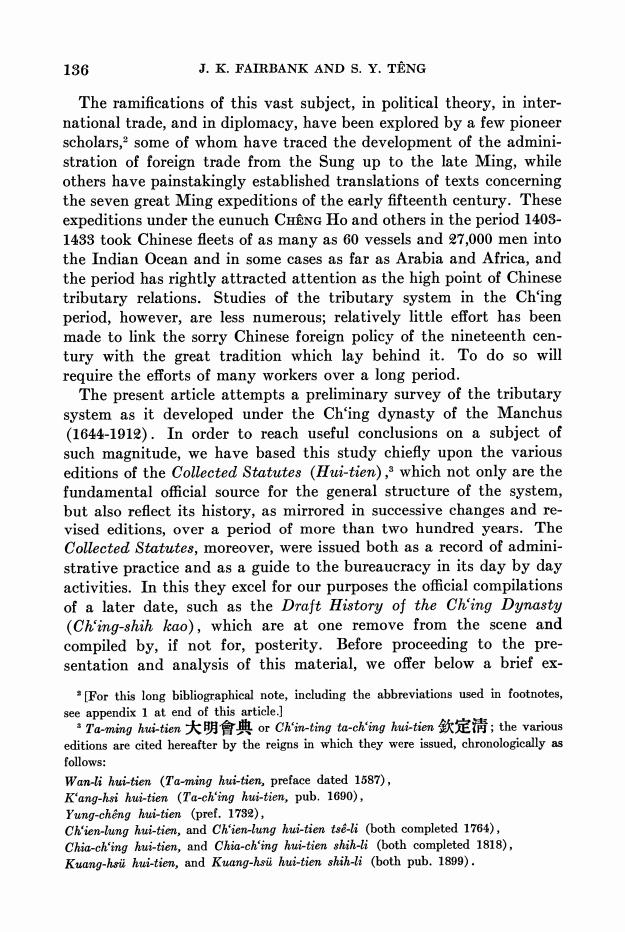正在加载图片...

186 J.K.FAIRBANK AND S.Y.TENG The ramifications of this vast subject,in political theory,in inter- national trade,and in diplomacy,have been explored by a few pioneer scholars,2 some of whom have traced the development of the admini- stration of foreign trade from the Sung up to the late Ming,while others have painstakingly established translations of texts concerning the seven great Ming expeditions of the early fifteenth century.These expeditions under the eunuch CHENG Ho and others in the period 1403- 1433 took Chinese fleets of as many as 60 vessels and 27,000 men into the Indian Ocean and in some cases as far as Arabia and Africa,and the period has rightly attracted attention as the high point of Chinese tributary relations.Studies of the tributary system in the Ch'ing period,however,are less numerous;relatively little effort has been made to link the sorry Chinese foreign policy of the nineteenth cen- tury with the great tradition which lay behind it.To do so will require the efforts of many workers over a long period. The present article attempts a preliminary survey of the tributary system as it developed under the Ch'ing dynasty of the Manchus (1644-1912).In order to reach useful conclusions on a subject of such magnitude,we have based this study chiefly upon the various editions of the Collected Statutes (Hui-tien),s which not only are the fundamental official source for the general structure of the system, but also reflect its history,as mirrored in successive changes and re- vised editions,over a period of more than two hundred years.The Collected Statutes,moreover,were issued both as a record of admini- strative practice and as a guide to the bureaucracy in its day by day activities.In this they excel for our purposes the official compilations of a later date,such as the Draft History of the Ch'ing Dynasty (Ch'ing-shih kao),which are at one remove from the scene and compiled by,if not for,posterity.Before proceeding to the pre- sentation and analysis of this material,we offer below a brief ex- [For this long bibliographical note,including the abbreviations used in footnotes, see appendix 1 at end of this article.] sTa-ming hui-tien大明會典or Ch'in-ting ta-ching hui--tien欽定清;the various editions are cited hereafter by the reigns in which they were issued,chronologically as follows: Wan-li hui-tien (Ta-ming hui-tien,preface dated 1587), K'ang-hsi hui-tien (Ta-ch'ing hui-tien,pub.1690), Yung-cheng hui-tien (pref.1732), Ch'ien-lung hui-tien,and Ch'ien-lung hui-tien tse-li (both completed 1764), Chia-ch'ing hui-tien,and Chia-ch'ing hui-tien shih-li (both completed 1818), Kuang-hsi hui-tien,and Kuang-hsi hui-tien shih-li (both pub.1899).136 J. K. FAIRBANK AND S. Y. TENG The ramifications of this vast subject, in political theory, in international trade, and in diplomacy, have been explored by a few pioneer scholars,2 some of whom have traced the development of the administration of foreign trade from the Sung up to the late Ming, while others have painstakingly established translations of texts concerning the seven great Ming expeditions of the early fifteenth century. These expeditions under the eunuch CHENG Ho and others in the period 1403- 1433 took Chinese fleets of as many as 60 vessels and 27,000 men into the Indian Ocean and in some cases as far as Arabia and Africa, and the period has rightly attracted attention as the high point of Chinese tributary relations. Studies of the tributary system in the Ch'ing period, however, are less numerous; relatively little effort has been made to link the sorry Chinese foreign policy of the nineteenth century with the great tradition which lay behind it. To do so will require the efforts of many workers over a long period. The present article attempts a preliminary survey of the tributary system as it developed under the Ch'ing dynasty of the Manchus (1644-1912). In order to reach useful conclusions on a subject of such magnitude, we have based this study chiefly upon the various editions of the Collected Statutes (Hui-tien),3 which not only are the fundamental official source for the general structure of the system, but also reflect its history, as mirrored in successive changes and revised editions, over a period of more than two hundred years. The Collected Statutes, moreover, were issued both as a record of administrative practice and as a guide to the bureaucracy in its day by day activities. In this they excel for our purposes the official compilations of a later date, such as the Draft History of the Ch'ing Dynasty (Ch'ing-shih kao), which are at one remove from the scene and compiled by, if not for, posterity. Before proceeding to the presentation and analysis of this material, we offer below a brief ex- 2 [For this long bibliographical note, including the abbreviations used in footnotes, see appendix 1 at end of this article.] 3 Ta-ming hui-tien *a At or Ch'in-ting ta-ch'ing hui-tien A ,; the various editions are cited hereafter by the reigns in which they were issued, chronologically as follows: Wan-li hui-tien (Ta-ming hui-tien, preface dated 1587), K'ang-hsi hui-tien (Ta-ch'ing hui-tien, pub. 1690), Yung-che'ng hui-tien (pref. 1732), Ch'ien-lung hui-tien, and Ch'ien-lung hui-tien tsei-li (both completed 1764), Chia-ch'ing hui-tien, and Chia-ch'ing hui-tien shih-li (both completed 1818), Kuang-hsui hui-tien, and Kuang-hsi hui-tien shih-li (both pub. 1899)